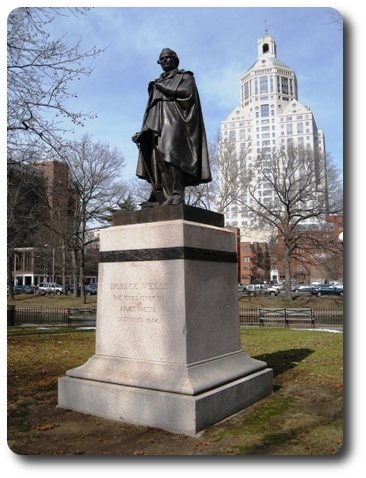
Close to the pond in the eastern portion of Bushnell Park sits a tall statue of Dr. Horace Wells. The inscription says that in December 1844 he discovered anesthesia. What an odd item to memorialize. Very important, but still a curious choice. I had to look a little deeper. Dr. Wells was a dentist and he lived a life that, if true, should be made into an episode of E! True Hollywood Stories.
According to (the internet) legend …
The art of dentistry was not nearly as refined in the 1840s as it is today. Dr. Wells did not go to medical school, but became a dentist after serving as an apprentice to practicing dentists. He opened his own shop in Hartford in 1836 and even published an essay on teeth. After growing tired of the constant screaming of his patients, he began thinking about ways to reduce their pain.
Nitrous Oxide was a well known gas during the 1840s, and it is said that there were even laughing gas parties where the participants enjoyed the feeling of euphoria. Dr. Wells, ever the keen observer, noted that a gentleman injured himself at one such event but did not seem to feel any pain. Perhaps the nitrous oxide would also work for dentistry!
Soon after, Dr. Wells tested the theory himself, taking a deep breath of the magical gas before an assistant removed one of his teeth. (Presumably there was something wrong with the tooth and it needed to be removed). He felt no pain! Dr. Wells began using nitrous oxide in his practice and eventually lined up a demonstration with the medical establishment in Boston.
The demonstration did not go well - the patient cried out in pain during the procedure. The audience severely boo-ed Dr. Wells, discrediting him in the medical community. To make matters worse, one of his students stole his spotlight, later gaining international fame for using ether as an inhaled anesthetic. Although he briefly continued to use nitrous oxide after returning to Hartford, Dr. Wells gave up his practice and became a traveling salesman. He ended up going to Europe on behalf of a former partner to promote the use of anesthesia.
After returning to the States, Dr. Wells decided to experiment on himself again. This time he was interested in understanding the effects of chloroform. He became increasingly deranged and in a fit rage ran into the street and threw sulfuric acid onto the clothes of two prostitutes in New York City. He was arrested and sent to the infamous Tombs Prison. As the effect of the drug wore off he realized what he had done and committed suicide in his cell.
Dr. Wells was later proven correct in his use of nitrous oxide, which is still in use today. In 1864 he was recognized by the American Dental Association as the discoverer of anesthesia. The Bushnell Park statue was commissioned in 1874 by a collection of dental and municipal organizations.
So that’s the story of Dr. Horace Wells - thank you for your contribution to dentistry, good sir!
References:
Horace Wells at Answers.com
Horace Wells at Wikipedia
Horace Wells at BushnellPark.org
Horace Wells at NNDB.com
ADA Timeline showing Discovery of Anesthesia

